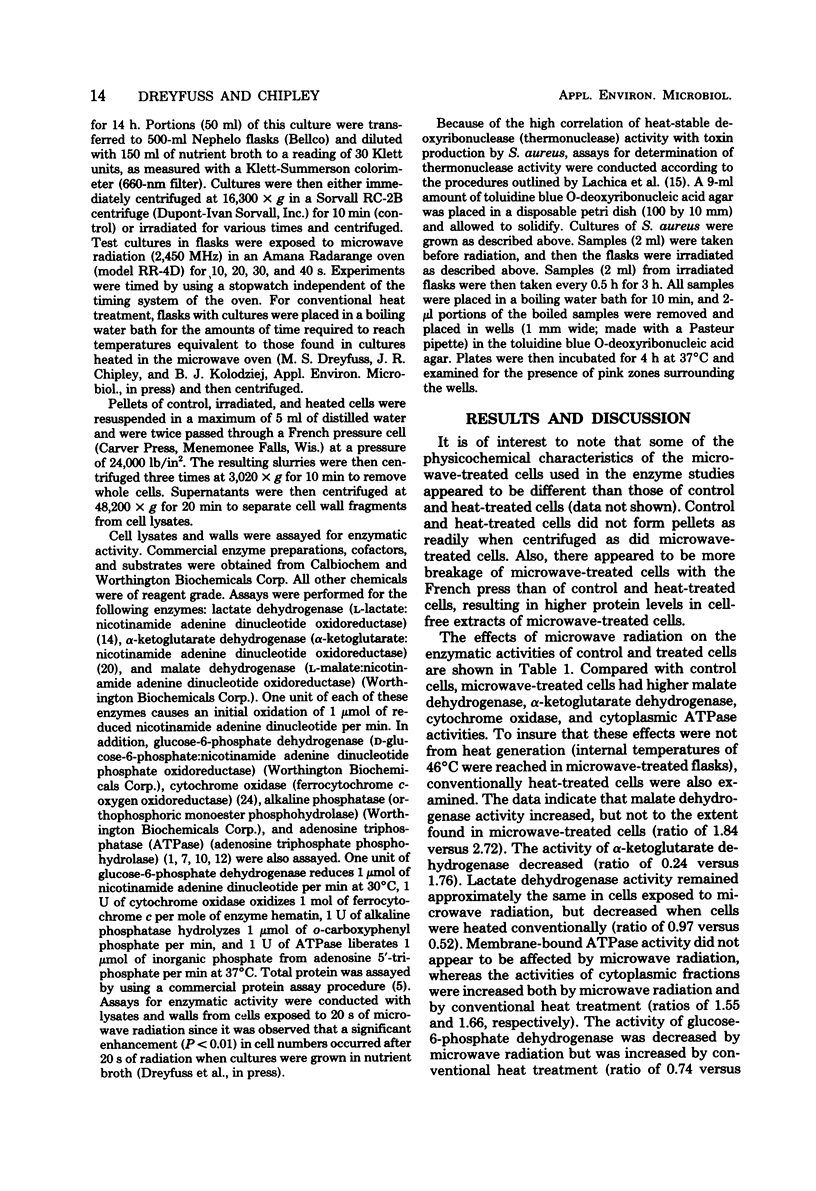Abstract
This study was conducted in an attempt to characterize some of the effects of sublethal microwave radiation on cells of Staphylococcus aureus. Cultures were exposed to microwave radiation for 10, 20, 30, and 40 s. The effects of a conventional heat treatment were also compared by placing flasks containing cultures in a boiling water bath for the amount of time required to reach temperatures equivalent to those found in cultures exposed to microwave radiation. Control, microwave-treated, and conventionally heat-treated cultures were centrifuged, pellets were resuspended in distilled water, and the resulting suspensions were passed through a French pressure cell. Cell lysates and walls were then isolated and assayed for enzymatic activity. Thermonuclease production was also determined at various levels of exposure of cells to microwave radiation. Activities of malate and α-ketoglutarate dehydrogenases, cytochrome oxidase, and cytoplasmic adenosine triphosphatase were higher in microwave-treated cells than in control cells. Membrane adenosine triphosphatase, alkaline phosphatase, and lactate dehydrogenase activities were unaffected when cells were exposed to microwave radiation. The activity of glucose-6-phosphate dehydrogenase was decreased by exposure of cells to microwave radiation. In conventionally heated cells, activities of glucose-6-phosphate and malate dehydrogenases and cytoplasmic adenosine triphosphatase increased activities of α-ketoglutarate and lactate dehydrogenases decreased, and alkaline phosphatase activity remained unaffected. Increased levels of thermonuclease activity were observed when cells were exposed to microwave radiation for 10 or 20 s. Data indicate that microwave radiation affects S. aureus in a manner which cannot be explained solely by thermal effects.
Full text
PDF



Selected References
These references are in PubMed. This may not be the complete list of references from this article.
- Abrams A. The release of bound adenosine triphosphatase from isolated bacterial membranes and the properties of the solubilized enzyme. J Biol Chem. 1965 Sep;240(9):3675–3681. [PubMed] [Google Scholar]
- Belkhode M. L., Johnson D. L., Muc A. M. Thermal and athermal effects of microwave radiation on the activity of glucose-6-phosphate dehydrogenase in human blood. Health Phys. 1974 Jan;26(1):45–51. doi: 10.1097/00004032-197401000-00005. [DOI] [PubMed] [Google Scholar]
- Berteaud A. J., Dardalhon M., Rebeyrotte N., Averbeck D. Action d'un rayonnement électromagnétique à longueur d'onde millimétrique sur la croissance bactérienne. C R Acad Sci Hebd Seances Acad Sci D. 1975 Sep 22;281(12):843–846. [PubMed] [Google Scholar]
- Bluhm L., Ordal Z. J. Effect of sublethal heat on the metabolic activity of Staphylococcus aureus. J Bacteriol. 1969 Jan;97(1):140–150. doi: 10.1128/jb.97.1.140-150.1969. [DOI] [PMC free article] [PubMed] [Google Scholar]
- Goldblith S. A., Wang D. I. Effect of Microwaves on Escherichia coli and Bacillus subtilis. Appl Microbiol. 1967 Nov;15(6):1371–1375. doi: 10.1128/am.15.6.1371-1375.1967. [DOI] [PMC free article] [PubMed] [Google Scholar]
- Harold F. M., Baarda J. R., Baron C., Abrams A. Inhibition of membrane-bound adenosine triphosphatase and of cation transport in Streptococcus faecalis by N,N'-dicyclohexylcarbodiimide. J Biol Chem. 1969 May 10;244(9):2261–2268. [PubMed] [Google Scholar]
- Henderson H. M., Hergenroeder K., Stuchly S. S. Effect of 2450 MHz microwave radiation on horseradish peroxidase. J Microw Power. 1975 Mar;10(1):27–35. doi: 10.1080/00222739.1975.11688939. [DOI] [PubMed] [Google Scholar]
- Lachica R. V., Genigeorgis C., Hoeprich P. D. Metachromatic agar-diffusion methods for detecting staphylococcal nuclease activity. Appl Microbiol. 1971 Apr;21(4):585–587. doi: 10.1128/am.21.4.585-587.1971. [DOI] [PMC free article] [PubMed] [Google Scholar]
- Lechowich R. V., Beuchat L. R., Fox K. I., Webster F. H. Procedure for evaluating the effects of 2,450-megahertz microwaves upon Streptococcus faecalis and Saccharomyces cerevisiae. Appl Microbiol. 1969 Jan;17(1):106–110. doi: 10.1128/am.17.1.106-110.1969. [DOI] [PMC free article] [PubMed] [Google Scholar]
- Straub K. D., Carver P. Effects of electromagnetic fields on microsomal ATPase and mitochondrial oxidative phosphorylation. Ann N Y Acad Sci. 1975 Feb 28;247:292–300. doi: 10.1111/j.1749-6632.1975.tb36004.x. [DOI] [PubMed] [Google Scholar]
- Tomlins R. I., Pierson M. D., Ordal Z. J. Effect of thermal injury on the TCA cycle enzymes of Staphylococcus aureus MF 31 and Salmonella typhimurium 7136. Can J Microbiol. 1971 Jun;17(6):759–765. doi: 10.1139/m71-121. [DOI] [PubMed] [Google Scholar]
- Vela G. R., Wu J. F. Mechanism of lethal action of 2,450-MHz radiation on microorganisms. Appl Environ Microbiol. 1979 Mar;37(3):550–553. doi: 10.1128/aem.37.3.550-553.1979. [DOI] [PMC free article] [PubMed] [Google Scholar]
- Webb S. J., Booth A. D. Absorption of microwaves by microorganisms. Nature. 1969 Jun 21;222(5199):1199–1200. doi: 10.1038/2221199a0. [DOI] [PubMed] [Google Scholar]
- Webb S. J., Dodds D. D. Inhibition of bacterial cell growth by 136 gc microwaves. Nature. 1968 Apr 27;218(5139):374–375. doi: 10.1038/218374a0. [DOI] [PubMed] [Google Scholar]
- Yeargers E. K., Langley J. B., Sheppard A. P., Huddleston G. K. Effects of microwave radiation of enzymes. Ann N Y Acad Sci. 1975 Feb 28;247:301–304. doi: 10.1111/j.1749-6632.1975.tb36005.x. [DOI] [PubMed] [Google Scholar]


